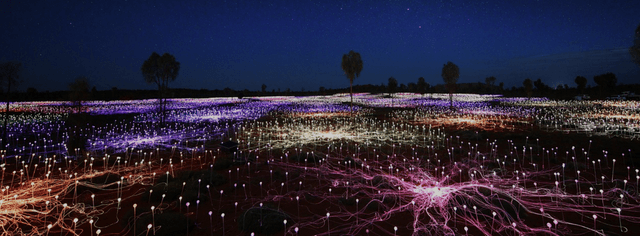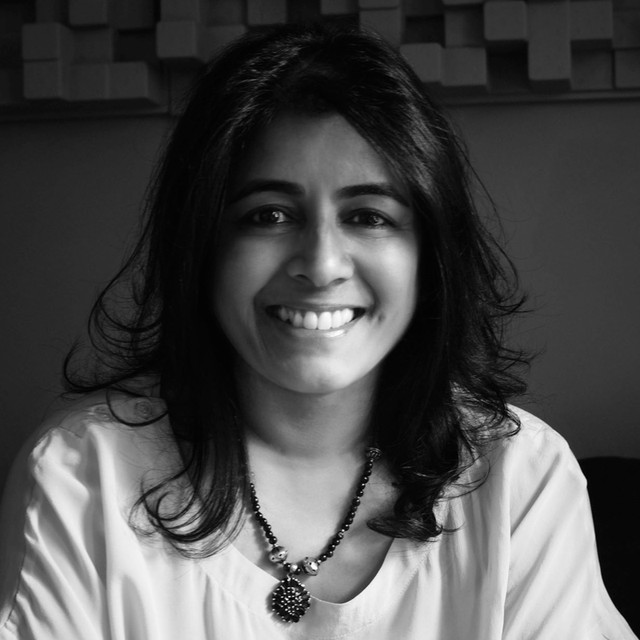
FIBER OPTIC SYMPHONIC ORCHESTRA
Tessellation is the score for artist Bruce Munro’s art installation ‘FOSO’ [Fiber Optic Symphonic Orchestra]. It is an abstract large scale outdoor installation of an entirely light-responsive orchestra.
An array of two meter high, five meter diameter light ‘columns’, each represent a ‘musician’ forming the layout of an orchestra. Each column is inspired and represented by the iconic Hill’s Hoist rotary washing line, an everyday Australian object that is also a beautiful structural support. Cylindrical arrays of fibre optic cables encircle each Hills Hoist, making it a column of light. A control system scrolls through a spectrum of colours synchronised to the score and as the fibre optic columns change hues, viewers experience sound translated into colour creating the immersive experience of an orchestra playing amid the lights. Different frequencies and pitches of sound are assigned different colours. FOSO’s light-responsive orchestra is designed to play ‘in time’ to the music, which means as you walk through the display, you can hear the individual instrument sections of the orchestra, ranging from the individual brass, string and woodwind elements to the electronics and vocals.
Using the symphonic orchestra including organic and electronic musical sounds, I wanted to take the listener on an exhilarating, emotional journey through nine musical pieces. While composing, in my mind’s eye, I would think of the visual layout; how all the colours and rhythms would interweave with one another. I conceptualised the patterns and shapes the installation would create with their emotional connection to the listener; from dense and rich, vibrant and colourful, to gentle and calming. The ebb and flow of the work would take you on a rollercoaster of building tension to a soft release of emotion.
THE ORIGIN
Tessellation is my ‘breaking-out-of-my-shell’ work; a voyage of musical self discovery. Having spent my career serving cinematic storytelling for Film, TV and Video Games, writing this work gave me the opportunity to create my own narrative.
Bruce’s only brief was that I should make full use of the symphonic orchestra, and that the piece should start and end with the idea of an orchestra tuning up. We recorded the live elements in Vienna Synchron Stage and hand picked soloists.
Having studied mathematics at degree level, I have always been intrigued by the relationship between music, mathematics and patterns in nature.
As a child, I studied Indian classical music and percussion, which is deeply rooted in mathematical and rhythmical principles. I was also interested in architecture and the intersection between art and science. Goethe said, “Music is liquid architecture; Architecture is frozen music”. Both share the principles of rhythm, harmony, energy and texture.
As a result I have distilled the essence of some of these early influences that have in some shape or form haunted me my whole life into Tessellation.
My fascination with the relationship between colour, sound and emotion also comes from my love of film. Vittorio Storaro was one of the great cinematographers renowned for ‘painting with light’ and his work in film had a profound influence on me growing up. The way that light interacts with matter creates an endless variety of colours and patterns, from the shimmering colours of a sunset to the dancing lights of the aurora borealis.
Numbers and circular patterns are found everywhere in the natural world. From the micro, where they are present in the structure of leaves, the pattern of a snail’s shell or the formation of tree branches, to the macro; found in the spirals arms of galaxies and patterns of stars. These circular patterns are the fundamentals of the Fibonacci sequence. They are also found in the divine proportion of consecutive numbers in the sequence called the Golden Ratio, an aesthetically pleasing proportion that can be found in the Pyramids of Giza to Da Vinci’s Mona Lisa.
THE MUSIC
I wanted to bring these ideas into the DNA of the compositions.
Spiral starts with the orchestra tuning up, and out of these seemingly random flutterings, a pattern starts to form like the pieces of a jigsaw puzzle that create an image; order is borne out of chaos, like the formation of a galaxy.
With Synchronicity, the use of repeating patterns and sequences of notes evoke a tension that must be resolved with an emotional rush of euphoria.
A Force of Nature uses certain harmonies and intervals to create a sense of calm and symmetry, giving an order and structure to our feelings and the world around us.
Touches of Spanish Flamenco and Indian classical rhythms blended with fragments of Asian sliding strings find their way into Altered States.
The idea of the circle of life, from birth to death, all the way through the passing of time with streams of rhythmic musical lines dancing and weaving in and out is a recurring concept that can be found in Tessellation.
I wanted the ebb and flow of Grain Of Enlightment to take the listener through romantic swirling murmurations of flowing energy, but my love of melody and the refined equilibrium and comfort find their way into many pieces such as Unravelling Wave and Constellations.
We eventually come back full circle to the very beginning with One Point Six One Eight, ending with the orchestra becoming more fragmented; back where we were, from order to chaos and fragments of sound. 1.618 is the Golden Ratio, the mathematical proof of the concept of love and the human perception of beauty. This is my attempt to bring out beauty from chaos, to find our place in the world and who we are.

Nainita Desai is an Emmy‑winning composer whose genre‑spanning scores have made her a leading voice in contemporary screen music. She has amassed a multitude of awards and nominations, including an Emmy for The Reason I Jump, RTS craft, IFMCA, SCL and World Soundtrack Award Discovery Of The Year wins and numerous nominations from the Ivor Novello, BIFA, Critics’ Choice and Cinema Eye Honors juries . In 2025 she captured ASCAP’s top video game prize for her score to Tales of Kenzera: Zau and her title theme for the Disney+/AMC fantasy series Nautilus (starring Shazad Latif) earned a nomination for Television Theme of the Year
Her current slate spans high‑profile television dramas, feature documentaries and triple‑A video games as well as upcoming projects for Nat Geo, Netflix and the BBC. Desai has scored the Disney+/AMC/Prime Video adventure series Nautilus, all three seasons of ITV’s crime drama The Tower (starring Gemma Whelan, Jimmy Akinbola) and EA’s acclaimed game Tales of Kenzera: Zau. On the festival circuit she is celebrated for the Sundance craft‑winning documentary Nocturnes (Cinema Eye 2025 nominee) and Hulu’s headline‑grabbing doc The Contestant.
She has also written for scripted series including BBC One’s Crossfire (starring Keely Hawes), Sky’s Funny Woman (starring Gemma Arterton) and StudioCanal’s feature Something in the Water. Her passion for natural history is evident in landmark series including The Wild Ones (Apple TV+), Earthsounds (Apple TV+), James Cameron’s Ocean Xplorers, National Geographic’s Secrets of the Penguins and Predators (Netflix).
Desai gained international acclaim for her scores to the Oscar‑nominated and Bafta / Cannes winning For Sama, Netflix’s14 Peaks: Nothing Is Impossible (Primetime Emmy nominated score), Body Parts (Emmy nominated score) and the hit A24/Netflix film The Deepest Breath. She has scored multiple No. 1 Netflix documentaries of the year, from American Murder: The Family Next Door to What Jennifer Did. Her music has been performed by renowned orchestras at festivals including Film Music Krakow, WSA Ghent, MOSMA Malaga, the Camille Awards in Paris, and SXSW London 2025.
Other projects include the recently released solo album Tessellation, created for a large scale permanent installation in California. In the world of interactive storytelling, Desai is celebrated for her collaborations with acclaimed game creator Sam Barlow, scoring the BAFTA-winning interactive movie-games Telling Lies and Immortality, and is currently scoring a multi-year international installation project alongside new AAA franchise games.
Born in London to Indian parents, Desai’s eclectic upbringing led her to study sitar, piano, guitar, tabla, violin, and voice. After earning a degree in mathematics, she trained in sound design at the National Film and Television School, going on to work as a sound designer on feature films including films for Bernardo Bertolucci and Werner Herzog, and as an assistant engineer for Peter Gabriel.
With a strong sense of narrative empathy, Nainita Desai’s music—whether sweeping orchestral fantasy, minimal understated scoring, experimental hand-crafted sound design, or dark, edgy electronics - is always emotionally immersive. Every project has its own unique sonic world, as she fuses custom-built instruments, vintage synths, found sounds, and global influences into scores that are both expansive and intimate, always rooted in the emotional truth of the story. Her approach has led to collaborations with artists from Eivør to the London Contemporary Orchestra, and to documentary-musicals such as the BBC’s City of Dreams.
Beyond composing, Desai is active in industry leadership. A BAFTA Breakthrough, she is an elected member of BAFTA’s Film Committee, the Oscars’ London committee, and the Ivors Academy senate. She co-founded the Oscars’ JGI initiative supporting Black British composers, has mentored on the Amazon and WFTV composer schemes, and holds voting membership in AMPAS, BAFTA, the Emmys, BIFA, and the Recording Academy. She regularly gives masterclasses at institutions and major festivals worldwide, and continues to champion diversity and innovation in screen music.